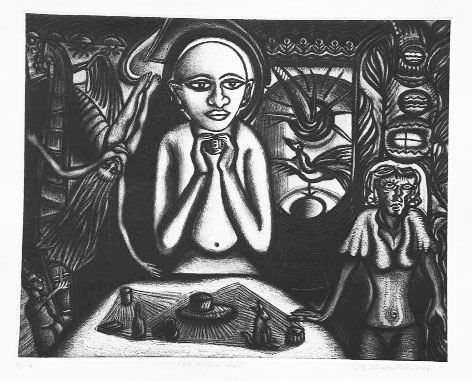Through six lithographs and four etchings, artist Sushanta Guha showcases the power of expression which could make one stop by and gaze at them for eternity, says U Nair
After many years, one saw a series of prints at the Visual Arts Gallery exhibition Multiple Encounters by mentor and printmaker Sushanta Guha that made you stop in your tracks and gaze for moments into eternity. Human figures — fantasy and inventiveness — all rolled into one as you look at the hand and the details and the power of expression in these six lithographs and four etchings that travelled through space and time for their intensity of depth and verve and virtuosity.
Among the greatest prints, has been Albrecht Dürer’s Rhinoceros that I saw at the National Gallery of Art in Washington DC. History states that Dürer was alive at the time Spanish conquistador Hernán Cortés and his partners were claiming the New World for Spain. The exotic valuables they brought back to King Charles V (weapons, jewellery, textiles and more) was the talk of Europe.
Indian Rhinoceros
Dürer saw a selection of Meso-American treasures on a trip to Brussels in August 1520. According to an entry in his travel diary, Dürer had ‘not seen anything in (his) whole life that delighted (his) heart as much as these, marvelously-artistic things.’
It was around this time that Portuguese adventurers caused an even greater sensation by transporting a rhinoceros to Europe from India for their king, Manuel I. Dürer never saw the animal himself but cashed in on the furore about it — producing a woodcut image of the rhino, based on a sketch by a German merchant in Lisbon. Dürer’s version came with numerous fanciful additions, intended to fire the viewer’s imagination — including folds of skin that looked like armour.
Richness of images
Coming back to Sushanta, he gives us a visual stew in which details dissolve into a primordial puddle and has a kind of repulsive yet resonant fascination. His squiggly line drawings take an ardent delight in things that multiply or mutate but in inventive, quirky forms. Sushanta creates yeasty transformations in drawing with all the linear subtlety and complexity of Albrecht Dürer engravings.
His etchings and lithographs strongly evoke the passionate prowess of the ‘Old Masters’ and it is this versatile quality that transformed the very taste and tensile offerings of this epic showcase of five printmakers.
Stunning lithographs
As a printmaker, Sushanta is a man of a few words, “I generally work consecutively in two different media — etching and lithograph. Although I have worked in all the disciplines in a printmaking media, lithography is my favourite medium,” says Sushanta. He adds, “I start with sketchy drawings first and then keep adding on along with my concept till the final drawing with complete satisfaction.”
The two media — different as they are — share the quality of mechanically simplifying the task of making and reproducing pictures. In lithography, artists draw directly on flat stones that also act as the printing plate. It’s a very supple and efficient method. Artists started working in olden years with historic examples. Sushanta’s works stood out because they gave a sense of being modern throughout.
Strength of imagery
There’s a touch of familiar time in Sushanta’s human figures. Even though the subject of the human figure is classical, the images he creates hover on the surface like a modern-day TV picture soaring through differential speeds. While he alludes to the idea of characters that swim through time and testimony, he also hints at the invention of the idea of artistic modernism through his technique and his tenor.
What defines a good lithograph? Firstly and foremost, it is a question of quality and how strong, clear and rich the image appears. Printing quality, however, is a matter of judgement and experience, and therefore subjective. In many instances there is hard evidence concerning chronology of the printing, as prints often existed in different states. But it is the clarity of images that defines the quality. The success of Sushanta’s prints lie in the quality of resultant details and impact on the viewer’s senses telling us about truths of printmaking.
So much of beauty and of what propels our pursuit of truth in artistic domains, stems from the invisible connections — between ideas, disciplines, denizens of a particular time and place, the interior world of each pioneer and the mark they leave on the cave walls of cultures. Sushanta’s human figures are like beings flitting from one phase of nocturne to another, causing through the torchlight of a revolution that lights the new day.


























